
- Jaigarh Fort, Jaipur
- Jaigarh Fort - Home
- Jaigarh Fort - Overview
- Jaigarh Fort - History
- Jaigarh Fort - Architecture
- Jaigarh Fort - How to Reach?
- Jaigarh Fort - Nearby Places
- Jaigarh Fort Useful Resources
- Jaigarh Fort - Quick Guide
- Jaigarh Fort - Useful Resources
- Jaigarh Fort - Discussion
Jaigarh Fort - Quick Guide
Jaigarh Fort - Overview
Jaigarh Fort is situated on Aravalli range and was built in order to protect Amer Fort. The fort faces Amer Fort and Maota Lake and was built in order to protect the Amer Fort. The fort is famous for the largest cannon on wheels that was developed here. The peak on which the fort was built is known as Cheel ka Teela or Hill of Eagles. The length of the fort is 3km while width is 1km.
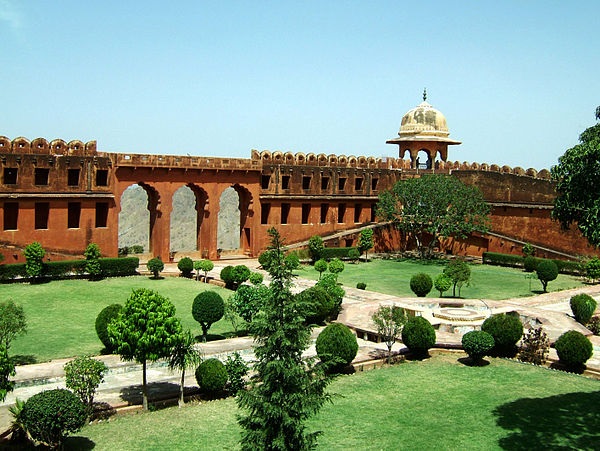
Jaipur
Jaigarh Fort is situated in Jaipur which is the capital of Rajasthan state in India. Maharaja Jai Singh founded the city in 1726. Jaipur is very popular from tourism point of view due to the presence of forts, palaces, temples and many other monuments. Besides Jaigarh Fort, people can visit Amer Fort, Hawa Mahal, City Palace, Jantar Mantar, Nahargarh Fort, Birla Mandir and many others. Since Jaipur is well-connected to various cities in India and abroad, people come to visit the monuments and know their history.

Visiting Hours
Jaigarh Fort is opened for the public on all days of the week from 9:00am to 4:30pm. It takes around one hour to visit the whole fort. The fort is opened on all days and all the government holidays and people can visit it any time during the visiting hours.
Ticket
Tourists have to pay an entry fees in order to visit the fort. For Indian tourists the fees is Rs. 35 and for foreign tourists, it is Rs. 85. If the tourists are carrying still camera or video camera, they have to pay additional charges. For Indians, the charges of still camera is Rs. 20 and Rs. 100 for video camera. For foreigners, the charges of still camera is Rs. 30 and Video camera is Rs. 100.
Best time to Visit
The best time to visit Jaipur is February to April and October to December. The climate is pleasant in these months as these months are neither very hot nor very cold. Rest of the months are not suitable as Jaipur has three climates, hot summers, cold winters, and monsoon.
Where to Stay?
There are around 933 hotels in Jaipur where tourists can stay. The hotel range from expensive five star hotels to inexpensive budget hotels. The name of some of the hotels are as follows −
Five-Star Hotels
Crowne Plaza located at Tonk Road
The Fern Located at Tonk Road
ITC Rajputana located nearby Railway Station
Ramada Hotel located at Raja Park
Country Inn and Suites located at M.I. Road
Four-Star Hotels
Lemon Tree Premier located at Bani Park
Park Prime Located at C Scheme
Hotel Royal Orchid located at Tonk Road
Vesta International located nearby Railway Station
Souvenir Premier located at Mansarovar metro station
Three-Star Hotels
Red Fox Hotel located at Malviya Nagar
Ibis Hotel located at Civil Lines
Ginger Hotel located at Civil Lines
The Theme located at Tonk Road
Rajasthan Palace Hotel located at Moti Doongri Road
Budget Hotels
Hotel Chetram located at Jaipur City Centre
Hotel Holiday Home located at Railway Station
Hotel Kalyan located at Railway Station
Hotel Mahadev Regency located at Station Road
Hotel Raghuraj Palace located at Shastri Nagar
Cheap Hotels
Hotel Tulsi Palace located at Amer Road
Royal Aashiyana Palace located at Bani Park
Nohra Homestay located at Vaishali Nagar
Hotel Royal Empire located at JLN Marg
Janpath Guest House located at Ajmer Road
Jaigarh Fort - History
Jaigarh Fort was built as a defensive fort in order to defend the Amer Fort. The fort was renovated by Raja Jai Singh in the 18th century. The design of the fort was made by Vidydhar. The fort was built as a residential place for the king and royal family. Later the fort was used to keep weapons.
Jaigarh Fort under Meenas
History also says that Jaigarh Fort is as old as the Amer Fort. The fort was built by Meenas during their rule in Amer. Since they worshipped Goddess Amba so they named the town as Amer or Amber.
Jaigarh Fort under Kachwahas
Kachwahas took over the city of Amer from Meenas and ruled during the Mughal period and later. During the rule of Aurungzeb, the fort was given to Raja Jai Singh II who renovated the fort. Raja Jai Singh also built the city of Jaipur which was his dream project. Like Jaigarh fort, Jaipur was also planned by Vidyadhar.

Jaigarh Fort during Mughal Period
During the Mughal period, the fort was used to keep weapons which was used in the wars. During the rule of Shah Jahan, Dara Shikoh looked after the work in the fort. When he was killed by his brother Aurungzeb, the fort came under Raja Jai Singh who renovated the fort.
During the rule of Akbar, Raja Maan Singh accepted to come under Akbar’s rule through a treaty. It was stated in the treaty that the kingdom that Maan Singh will win will come under Mughal rule and the treasure will belong to Maan Singh. He won many places in Afghanistan and others and got a huge treasure which was kept in Jaigarh Fort. Jaigarh Fort is also known as Victory Fort as nobody was able to capture the fort.
Jaigarh Fort - Architecture
The walls of the fort are very thick and are made up of red sandstone. The length of the fort is 3km and the width is 1km. There are many structures built inside the fort which include Laxmi Vilas, Lalit Mandir, Aram Mandir, and Vilas Mandir. Besides all these, the fort has a beautiful garden which still exists. The largest cannon on wheels, known as Jaivana, is also there in the fort.
Garden
Jaigarh Fort has a square shaped garden which is spread in an area of 50m2. The name of the garden is Charbagh as it is divided into four equal parts. Each part of the garden has flower beds containing different species of flowers. The garden is located in the courtyard of the fort.
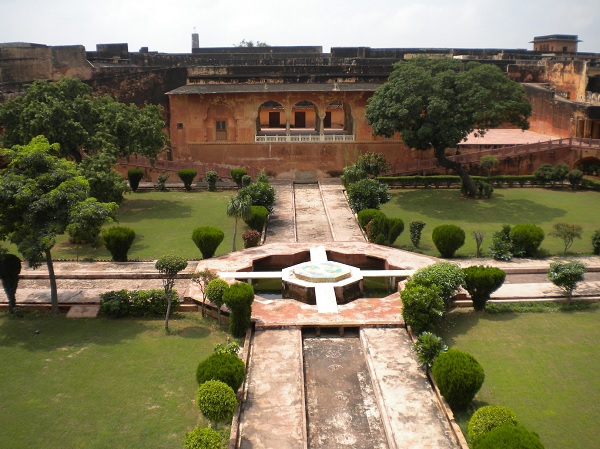
Palaces
The palaces of the fort have large halls and court rooms. The windows were screened which looked very beautiful. There is a central watch tower that was built on a raised platform. Another noticeable thing is the Awani Darwaza from where Sagar Lake can be viewed. The gateway is triple arched and is painted with red and yellow colors.
Armory
There is an armoury chamber where the tourists can find various weapons like swords, muskets, guns, and cannon balls. There are also pictures of Maharajas like Sawai Bhavani Singh and Major General Man Singh who was the one of the senior officers in Indian army.
Jaivana Cannon
Jaivana cannon is the largest cannon on wheel developed in 1720. As Rajputs and the Mughals have very friendly relations, the cannon was never used. The cannon was used only once to test its range. When it was filled with gunpowder of 100kg and fired, the range was found to be around 35km. The cannon was developed during the reign of Sawai jai Singh II. The length of the barrel is 6.15m and weight is 50 tonnes.
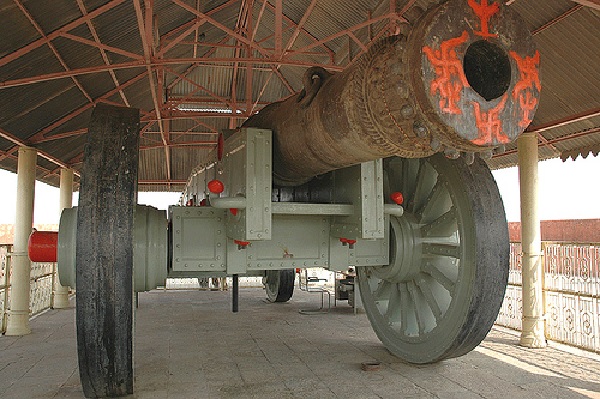
Other Structures
Ram Harihar Temple and Kal Bhairav Temple are the two temples in the fort. Ram Harihar temple was built in 10th century while Kal Bhairav temple was built in 12th century. There are three tanks in the centre of the courtyard that were filled with water for use in the fort.
Jaigarh Fort - How to Reach?
Jaipur is connected various cities by air, rail, and road transport. Some of the nearby cities with their distance from Jaipur are as follows −
Jaipur to Ajmer
By road – 134km
By rail – 92km
By air – 121km
Jaipur to Jodhpur
By road – 337km
By rail – 311km
By air – 282km
Jaipur to Jaisalmer
By road – 568km
By rail – 665km
By air – 481km
Jaipur to Bikaner
By road – 336km
By rail – 345km
By air – 272km
Jaipur to Delhi
By road – 268km
By rail – 288km
By air – 241km
Jaipur to Lucknow
By road – 571km
By rail – 559km
By air – 514km
Jaipur to Agra
By road – 242km
By rail – 228km
By air – 222km
Jaipur to Ahmedabad
By road – 664km
By rail – 620km
By air – 534km
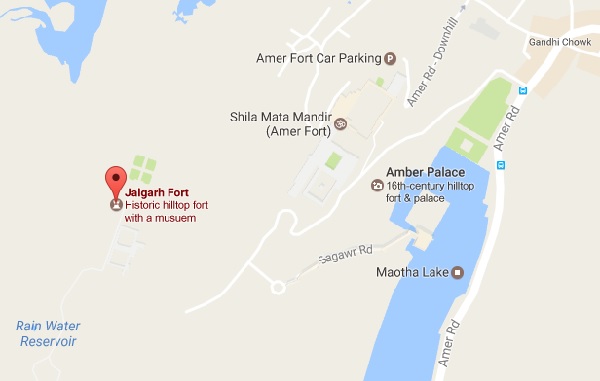
By Air
Jaipur is connected to various major cities by air as the city has its airport at Sanganer which is 12 km away from the city. International and domestic flights land here. The airlines whose national and international flights land in Jaipur are Jet Airways, Air India, Oman Air, SpiceJet, and IndiGo.
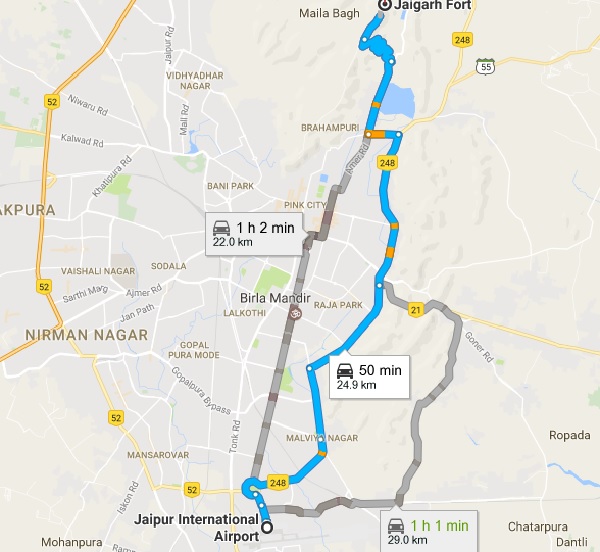
By Rail
Jaipur is connected to various cities in India through trains. Many long and short-distance train start, end, or pass through Jaipur. Premium trains like Shatabdi, Rajdhani, Duronto, Double Decker, Garib Rath trains connect Jaipur to various cities.
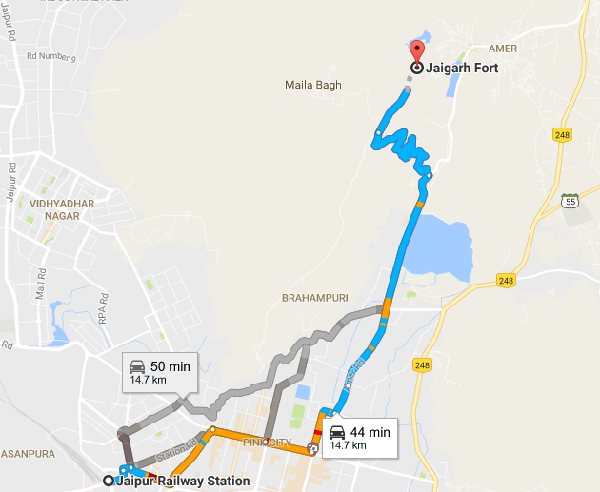
Many superfast trains and fast mail and express trains also pass through Jaipur. The main railway stations of Jaipur are Jaipur Junction, Jaipur Gandhinagar, Getor Jagatpura, and Durgapura.
By Road
Jaipur is connected to many cities through a network of national highways. Bus services are provided by Rajasthan State Road Transport Corporation (RSRTC) to go to and come from Delhi, Agra, Ahmedabad, Ajmer, Udaipur and many other cities. The tourists can get both AC and non-AC buses for various routes. The buses can be boarded from Sindhi Camp bus stand.
Local Transport
In order to visit various places in Jaipur, tourists can get the facility of prepaid taxis which they can get from railway stations and airport. Cycle-rickshaw and three-wheelers are also available to go to the places at short distance. Besides these, local mini-buses, and AC and non-AC low-floor buses are also available. Metro rail is under construction though Mansarovar to Chandpol bazar is functional.
Jaigarh Fort - Nearby Places
There are many places nearby Jaigarh Fort which the people can visit and get to know the history about those places. The places nearby Jaigarh Fort are Amer Fort, Nahargarh Fort, Jagat Shiromani Ji Temple, Panna Meena ka Kund etc.
Amer Fort
Amer Fort is located at a distance of 11km from Jaipur. The fort is spread in an area of 4km2 and was built on the basis of Hindu architecture. The fort was ruled by Meenas, Kachwahas, Mughals, Marathas and the British. Marble and red sandstone is used to build the fort. It includes many structures like public hall or Diwan-i-Aam, private hall or Diwan-i-Khas, Sheesh Mahal, and many others.
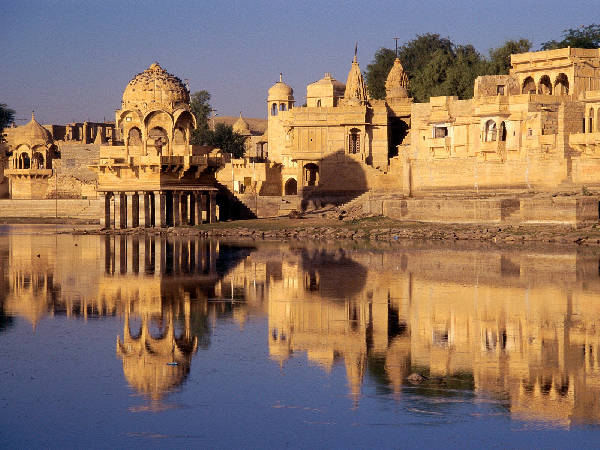
Nahargarh Fort
Nahargarh Fort was also built to protect the Amer Fort. Previously its name was Sudarshangarh which later changed to Nahargarh which means abode of tigers.
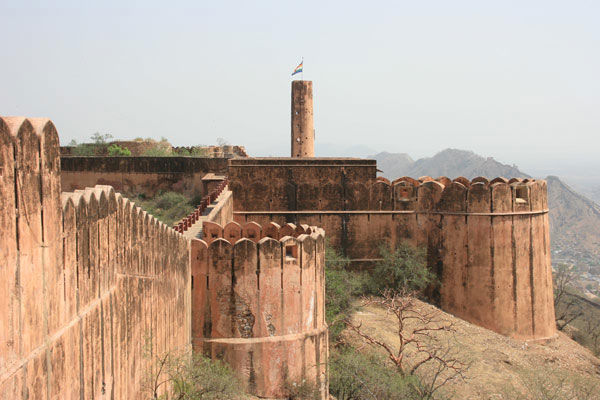
The fort was built by Sawai Jai Singh II in 1734. Sawai Ram Singh extended the fort in 1868 while Sawai Madho Singh built many palaces between 1883 and 1892.
Jagat Shiromani Temple
Jagat Shiromani Temple is situated in Amer where Meera Bai, Sri Krishna, and Lord Vishnu are worshipped. Queen Kankawati was the wife of Raja Man Singh I and she built this temple between 1599 and 1608 AD. The distance between the temple and Jaigarh Fort is 5.4km.
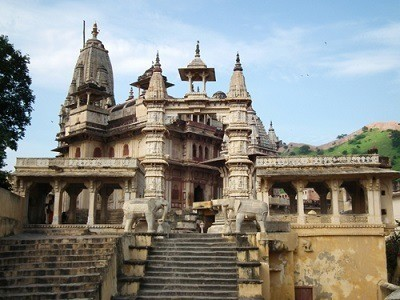
Panna Meena ka Kund
Panna Meena ka Kund also known as Panna Mian ki Baori or Panna Mian ka Kund. It is located at the distance of 5.6km from Jaigarh Fort. The kund is located near Anokhi Museum.
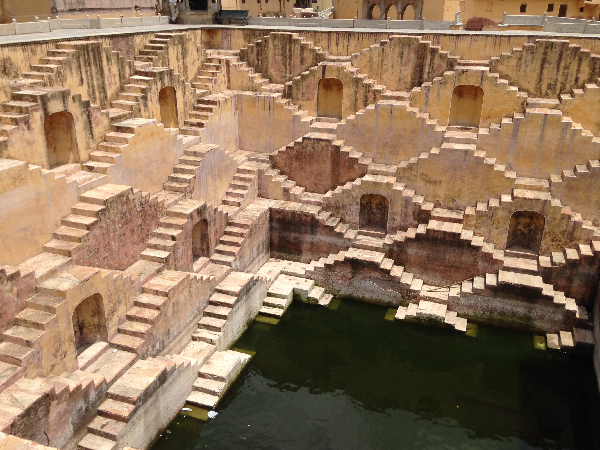
It was built in 16th century for the people to swim and to relax. As the ground remained cool during summer, people came here during summer especially in afternoon.
Jal Mahal
Jal Mahal is located in the middle of the Man Sagar Lake which is around 1.9km from Amer. Raja Jai Singh II built the palace in 18th century for his residence. The construction includes both Rajput and Mughal architecture.
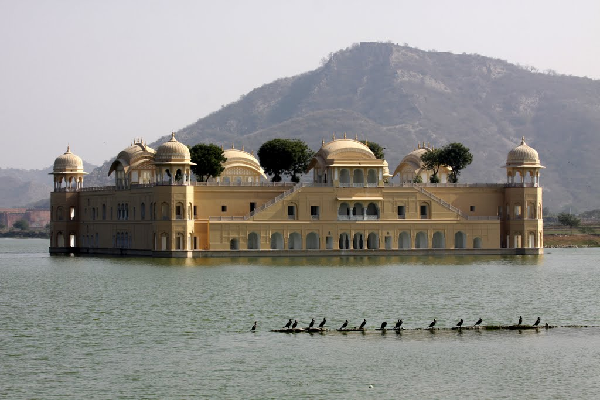
Tourists have to use a boat in order to reach the Jal Mahal. Red sandstone is used to build the five-storey palace. Its restoration has been taken up by Rajasthan Government.
To Continue Learning Please Login